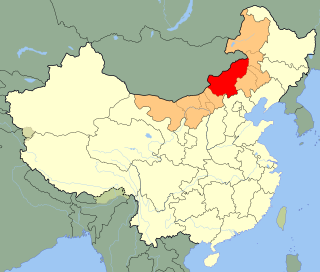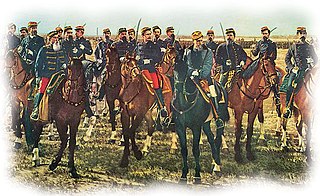 W
WOn the night of May 10, 2011 an ethnic Mongol herdsman was killed by a coal truck driver near Xilinhot, Inner Mongolia, China. The incident, alongside grievances over mining development in the region and the perceived erosion of traditional lifestyle of indigenous peoples, led to a series of Mongol protests across Inner Mongolia. Some 2000 students participated in protests at Communist Party headquarters of the West Ujimqin Banner, followed by demonstrations by secondary school students in the Xilinhot area. Select secondary schools and universities with large ethnic Mongol populations were reportedly under "lockdown". The Inner Mongolia government under Hu Chunhua tightened security in Inner Mongolian cities, including dispatching People's Armed Police troops to central Hohhot.
 W
WThe Chechen–Russian conflict refers to various conflicts between the Russian government and various Chechen forces.
 W
WThe Conquest of the Desert was an Argentine military campaign directed mainly by General Julio Argentino Roca in the 1870s with the intention of establishing dominance over the Patagonian Desert, inhabited primarily by indigenous peoples. Under General Roca, the Conquest of the Desert extended Argentine power into Patagonia and ended the Chilean expansion there.
 W
WThe Dungan Revolt (1862–1877) or Tongzhi Hui Revolt or Hui (Muslim) Minorities War was a war fought in 19th-century western China, mostly during the reign of the Tongzhi Emperor of the Qing dynasty. The term sometimes includes the Panthay Rebellion in Yunnan, which occurred during the same period. However, this article relates specifically to the uprising by members of the Muslim Hui and other Muslim ethnic groups in China's Shaanxi, Gansu and Ningxia provinces, as well as in Xinjiang, between 1862 and 1877.
 W
WThe Dungan revolt (1895–1896) was a rebellion of various Chinese Muslim ethnic groups in Qinghai and Gansu against the Qing dynasty, that originated because of a violent dispute between two Sufi orders of the same sect. The Wahhabi inspired Yihewani organization then joined in and encouraged the revolt, which was crushed by loyalist Muslims.
 W
WThe first Fiji expedition undertaken by the United States occurred in October 1855 during the civil war on the islands. In response to the alleged arson attacks on the American commercial agent in Lautoka, Viti Levu, the navy sent a warship to demand compensation for the attack from Seru Epenisa Cakobau, the Vunivalu of Bau and self-proclaimed Tui Viti.
 W
WThe Formosa Expedition, or the Taiwan Expedition of 1867, was a punitive expedition launched by the United States against Formosa. The expedition was undertaken in retaliation for the Rover incident, in which the Rover, an American bark, had been wrecked and its crew massacred by aboriginal Paiwan warriors in March 1867. A United States Navy and Marine company landed in southern Formosa and attempted to advance into the native village. The natives deployed a significant amount of guerrilla warfare, which they ambushed, skirmished, disengaged and retreated repeatedly. Eventually, the Marines ceased their pursuit when their commander was killed and retreated back to their ship due to fatigue and heat exhaustion, with the Formosans dispersing and retreating back into the jungle. The action is regarded as an American failure.
 W
WIn the Jahriyya revolt of 1781 sectarian violence between two suborders of the Naqshbandi Sufis, the Jahriyya Sufi Muslims and their rivals, the Khafiyya Sufi Muslims, led to Qing intervention to stop the fighting between the two, which in turn led to a Jahriyya Sufi Muslim rebellion which the Qing dynasty of China crushed with the help of the Khufiyya (Khafiyya) Sufi Muslims.
 W
WThe Japanese punitive expedition to Taiwan in 1874, referred to in Japan as the Taiwan Expedition and in Taiwan and China as the Mudan incident, was a punitive expedition launched by the Japanese in retaliation for the murder of 54 Ryukyuan sailors by Paiwan aborigines near the southwestern tip of Taiwan in December 1871. The success of the expedition, which marked the first overseas deployment of the Imperial Japanese Army and Imperial Japanese Navy, revealed the fragility of the Qing dynasty's hold on Taiwan and encouraged further Japanese adventurism. Diplomatically, Japan's embroilment with China in 1874 was eventually resolved by a British arbitration under which Qing China agreed to compensate Japan for property damage. Some ambiguous wording in the agreed terms were later argued by Japan to be confirmation of Chinese renunciation of suzerainty over the Ryukyu Islands, paving the way for de facto Japanese incorporation of Ryukyu in 1879.
 W
WThe Kuomintang Islamic insurgency refers to a continuation of the Chinese Civil War by Chinese Muslim nationalist Kuomintang Republic of China Army forces in Northwest China, in the provinces of Gansu, Qinghai, Ningxia, and Xinjiang, and another insurgency in Yunnan.
 W
WThe Moro conflict is an insurgency in the Mindanao region of the Philippines, which has involved multiple armed groups, and has been ongoing since March 1968.
 W
WThe Musha Incident (Chinese and Japanese: 霧社事件; pinyin: Wùshè Shìjiàn; Wade–Giles: Wu4-she4 Shih4-chien4; rōmaji: Musha Jiken; Pe̍h-ōe-jī: Bū-siā Sū-kiāⁿ), also known as the Wushe Rebellion and several other similar names, began in October 1930 and was the last major uprising against colonial Japanese forces in Japanese Taiwan. In response to long-term oppression by Japanese authorities, the Seediq Indigenous group in Musha (Wushe) attacked the village, killing over 130 Japanese. In response, the Japanese led a relentless counter-attack, killing over 600 Seediq in retaliation. The handling of the incident by the Japanese authorities was strongly criticized, leading to many changes in Aboriginal policy.
 W
WThe Nuku Hiva Campaign was an armed conflict between the United States and the Polynesian inhabitants of Nuku Hiva during the War of 1812. It occurred in 1813, following Captain David Porter's decision to sail his fleet to the island for repairs before continuing his raid against British shipping. Upon arrival, the Americans became involved in a tribal war and allied themselves with the Te I'i people against the Happah and Tai Pi clans.
 W
WThe Nukapu expedition was a British punitive expedition from October 1871 until February 1872, in response to the murder of missionary John Coleridge Patteson by natives of Nukapu, one of the easternmost islands of the Solomon Islands in the South Pacific Ocean. A Royal Navy warship was sent to the island, sinking a group of hostile war-canoes and landing men to attack a fortified village.
 W
WThe Osage Indian murders were a series of murders of Osage Native Americans in Osage County, Oklahoma, during the 1910s–1930s; newspapers described the increasing number of unsolved murders as the Reign of Terror, lasting from 1921 to 1926. Some sixty or more wealthy, full-blood Osage Native Americans were reported killed from 1918 to 1931. However, newer investigations indicate that other suspicious deaths during this time could have been misreported or covered up murders, including people who were heirs to future fortunes.
 W
WThe Papua conflict is an ongoing conflict in Western New Guinea between Indonesia and the Free Papua Movement. Subsequent to the withdrawal of the Dutch administration from the Netherlands New Guinea in 1962 and implementation of Indonesian administration in 1963, the Free Papua Movement has conducted a low-intensity guerrilla war against Indonesia through the targeting of its military, police, and civilians.
 W
WProtests and uprisings in Tibet against the government of the People's Republic of China have occurred since 1950, and include the 1959 uprising, the 2008 uprising, and the subsequent self-immolation protests.
 W
WThe Reapers' War, also known as the Catalan Revolt was a conflict that affected a large part of the Principality of Catalonia between the years of 1640 and 1659. It had an enduring effect in the Treaty of the Pyrenees (1659), which ceded the County of Roussillon and the northern half of the County of Cerdanya to France, splitting these northern Catalan territories off from the Principality of Catalonia and the Crown of Aragon, and thereby receding the borders of Spain to the Pyrenees.
 W
WThe Revolt of the Barretines also known as the Revolt of the Gorretes, was a Catalan rebellion fought against the government of King Charles II of Spain. The most salient complaint was against the government's quartering of soldiers. Other issues of contention were tax protests and Catalan nationalistic tensions. The revolt was funded and intensified by agents of France as part of the War of the Grand Alliance. Civil disorder lasted from 1687 to 1689.
 W
WThe Russian conquest of the Caucasus mainly occurred between 1800 and 1864. In that era the Russian Empire expanded to control the region between the Black Sea and Caspian Sea, the territory that is modern Armenia, Azerbaijan, Georgia, and parts of Iran and Turkey, as well as the North Caucasus region of modern Russia. Multiple wars were fought against the local rulers of the regions, as well as the dominant powers, the Ottoman Empire and Qajar Iran, for control. By 1864 the last regions were brought under Russian control.
 W
WThe 2008 Tibetan unrest was a series of protests and demonstrations over the Chinese government's treatment and persecution of Tibetans. Protests in Lhasa by monks and nuns on 10 March have been viewed as the start of the demonstrations. Numerous peaceful protests and demonstrations were held to commemorate the 49th anniversary of the 1959 Tibetan Uprising Day, when the 14th Dalai Lama escaped from Tibet. The protests and demonstrations spread spontaneously to a number of monasteries and throughout the Tibetan plateau, including into counties located outside the designated Tibet Autonomous Region. The arrest of monks at Labrang Monastery increased the tension of the situation. Violence began when Chinese police and People's Liberation Army units used force on non-violent protests by monks and nuns, and spread when protesting Tibetans later clashed with security forces. Clashes also occurred between Tibetans and Chinese Han and Hui residents, resulting in Han and Hui stores and buildings being destroyed and numerous Chinese civilians being injured or killed.